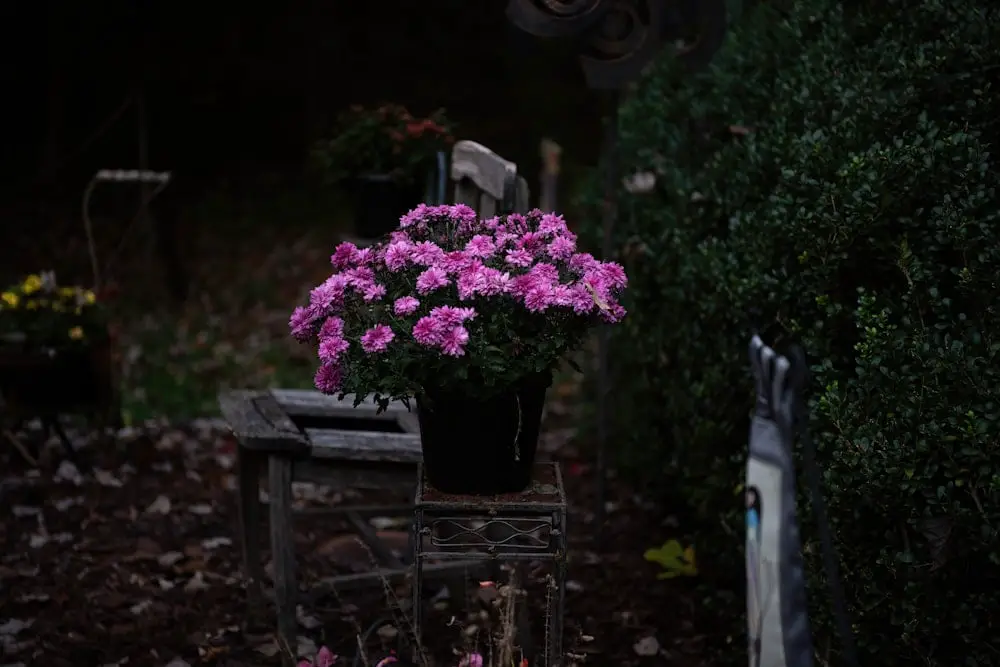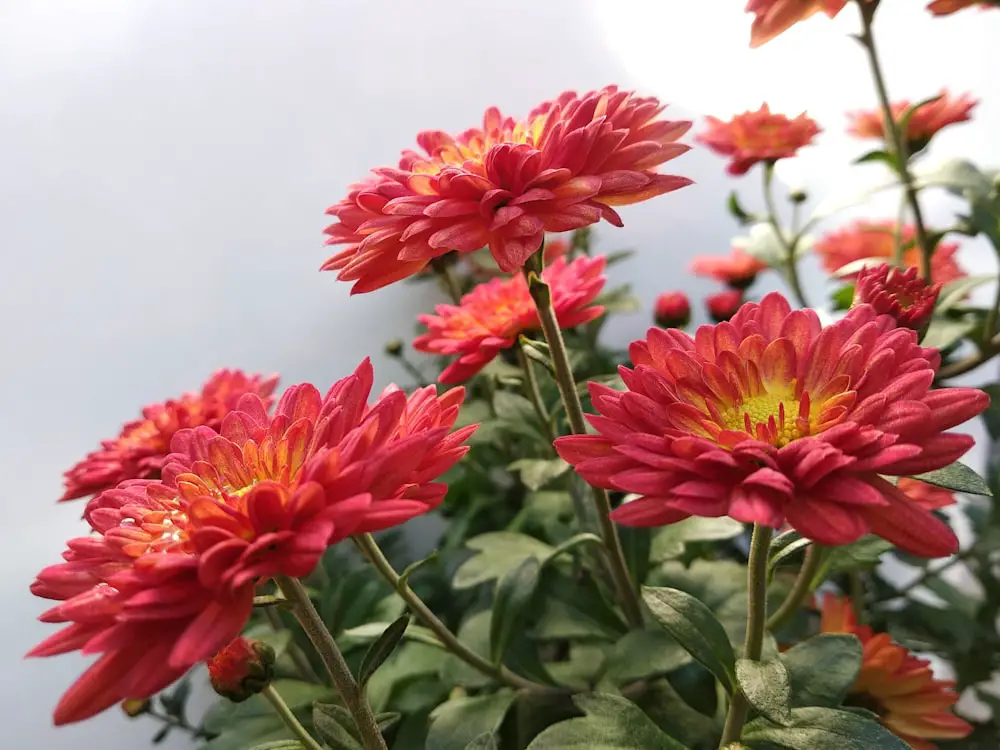As spring unfurls its colors, gardeners and flower lovers eagerly anticipate the vibrant display of mums. Known for their diverse varieties, mums in spring are a sight to behold.
Springtime sees mums busily preparing for their autumn glory. The lush greenery of their leaves becomes denser, providing a vivid backdrop in gardens still waking up from winter’s sleep.
This green stage is crucial. It’s when the plants gather strength, channeling energy into the roots and leaves, setting the stage for the colorful blooms that come later in the year.
Mums don’t usually flaunt their famous blossoms until late summer or fall when they explode in a carnival of colors, ranging from bright yellows to deep purples.
Let’s take a closer look at the beauty of mums in this article.
Key Points
- Mums are a vibrant and lush addition to any garden in the spring, producing colorful flowers in a variety of shades.
- The life cycle of mums includes growth in the spring, peak bloom in the fall, and dormancy in the winter.
- Pruning mums in early spring can help promote healthy growth and flower production.
- Proper care for mums includes ideal planting conditions, fertilizing, pinching for healthy growth, mulching, weed control, and pest and disease management.
- There is no difference between spring mums and fall mums in terms of the plant species, as they are all Chrysanthemums. The difference lies in the timing and purpose of purchasing the plant.
Mums in the Spring
Mums are best planted in the spring for maximum bloom output in the summer and fall.
They look quite vibrant and lush in spring. Watching the buds gradually open to reveal their full glory is a reminder of nature’s cycles and beauty.
Additionally, these flowers are known for their resilience. They can withstand the unpredictable weather of spring, making them a reliable choice for gardeners.
The plant itself is quite bushy with long, divided leaves. The flowers can be daisy-like, decorative, pompon, or buttons.
They are not typically in full bloom until late summer or fall, but in the spring they will start growing new shoots and leaves.
To understand why they look like this, it’s important to discuss the life cycle of mums throughout the seasons.
The Mum Cycle
Mums, or Chrysanthemums, have a beautiful life cycle that is influenced by the seasons.
Spring
During the spring season, mums begin to emerge from their dormancy and start producing new growth. The plant may produce new shoots and buds, and eventually bloom with vibrant flowers in a variety of colors.
As the weather warms up, the mums continue to grow and flourish, attracting pollinators, such as bees and butterflies.
Read also: How To Grow Chrysanthemums In Pots
Summer
In the summer months, the mums continue to thrive and produce new growth. The flowers may start to fade and wilt as the season progresses, but the plant continues to produce new buds and blooms to replace the old ones.
It is essential to provide ample water and nutrients to the plant during this time to support its growth.
Keep the mums pruned or pinched back until mid-summer. This will keep them bushy and compact, and also promote branching and blooming in the fall.
Fall
As fall approaches, the mums reach their peak bloom and display a stunning array of colors. The cooler temperatures and shorter days trigger the plant to produce more flowers as it prepares for the winter months ahead.
It is crucial to protect the mum plant from frost and cold temperatures during this time to ensure its survival.
Winter
In winter, the mums enter a period of dormancy and conserve their energy for the upcoming spring. The plant may appear dormant or die back to the ground, depending on the climate and growing conditions.
It is essential to protect the mum plant from extreme cold and provide adequate insulation to prevent damage to the roots and stem.

How to Prune Mums in Early Spring
Spring pruning is a good way to ensure your mums survive the winter. It’s good to wait until spring to prune your mums, as pruning too early can leave them vulnerable to frost damage.
Here’s a step-by-step guide on how to prune your mums:
Step 1: Start by removing any dead or damaged stems from the plant. Use a pair of sharp pruning shears to make clean cuts at the base of the stems.
Step 2: Thin out the plant by removing any weak or overcrowded stems. This will help improve air circulation and sunlight penetration, promoting healthy growth.
Step 3. Cut back the remaining stems to about 6-8 inches tall. Make your cuts just above a set of healthy leaves or buds to encourage new growth.
Step 4. Remove any old or woody growth from the center of the plant, as this can inhibit new growth and flowering.
Step 5. As you prune, keep an eye out for signs of pests or disease. If you notice any issues, treat them immediately to prevent further damage to your mums.
Step 6. After pruning, water your mums thoroughly to help them recover from the stress of pruning. Apply a balanced fertilizer to encourage new growth.
Note: Throughout the spring and summer, continue to deadhead your mums by removing spent flowers to promote continuous blooming. You should also pinch back new growth periodically to promote a bushier, more compact plant.
How to Care for Mums in Your Garden
Here are some things that can help you better care for your chrysanthemums and ensure they grow beautifully.
Ideal Planting Conditions for Mums
Mums flourish best when planted in a sunny area with well-drained soil. Depending on the size of the mum variety, the plants should be spaced at least 18 to 36 inches apart.
They should be kept sufficiently hydrated but are not to be left in standing water or overwatered.
Read also: Do Mums Like Sun Or Shade?
Fertilizing Your Mums
It is recommended to fertilize your mums once a month during May, June, and July using either a 5-10-10 or 5-20-20 granulated fertilizer.
Apply about 2-3 pounds of the fertilizer per 100 square feet of mums and make sure it’s well integrated into the soil.
Refrain from fertilizing when flower buds start to form in late July to prevent overproduction of foliage at the expense of flowers.
Pinching Mums for Healthy Growth
Pinching mums can encourage fuller, more attractive plant growth. This practice involves removing new growth, retaining only two or three leaves on every shoot.
Pinching should be done once a month from May to July. But if your mum plant is an early bloomer, avoid pinching in July to protect new flower heads.
Mulching, Weed Control, Pest and Disease Management
Promptly remove weeds around mums as they appear to prevent any competition for essential resources.
A 2-inch layer of mulch over the root system during the summer can keep the soil cool and adequately moist. Various mulches like peat moss, sawdust, bark chips, or even recycled plastic work well.
Mums are generally pest and disease-resistant, but aphids can occasionally be an issue. In case of white powdery mildew affecting the foliage, apply a targeted fungicide as per the instructions.

What Is the Difference Between Spring Mums and Fall Mums?
Unless you bought anything that looks like mums but is another species, there is no distinction between spring and fall mums. They’re all Chrysanthemums.
That said, mums can be ‘tricked’ into blooming in greenhouses by varying the amount of light they get. This is why we can have chrysanthemums that produce flowers in the fall and another in the spring.
The plant itself, however, is the same. Whether you buy in the spring or the fall, you’re getting a chrysanthemum. The difference is essentially in the timing and purpose of your purchase.
Final Thoughts
Mums in the spring are a beautiful sight to behold with their vibrant colors, lush foliage, and variety of flower shapes.
Whether you plant them in the spring or fall, mums are a wonderful addition to any garden or landscape, providing bursts of color and life throughout the year.
So, go ahead and plant some mums this spring to enjoy their beauty and elegance in your outdoor space.
